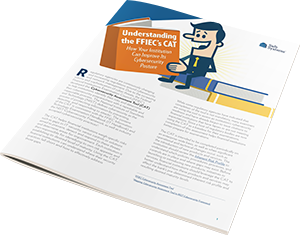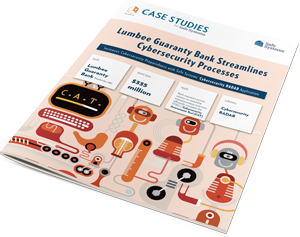
As cyber-attacks become increasingly more sophisticated, community banks struggle to ensure their institutions are adequately protected and in compliance with regulatory requirements and expectations. Regulators are heavily scrutinizing bank processes to verify that these institutions can effectively safeguard sensitive financial information. The Federal Financial Institutions Examination Council’s (FFIEC) Cybersecurity Assessment Tool (CAT), which was released in June 2015 and is designed to ensure banks are prepared in the event of a cybersecurity attack, is not a requirement to complete but it is what regulators are using to examine institutions and determine their level of cybersecurity preparedness.
This has led many banks to complete the CAT and examine their cybersecurity preparedness. Although the assessment is beneficial, it can also be a time-consuming task to understand and successfully manage. As a result, bankers are seeking a more efficient way to complete the assessment, understand their level of risk and make improvements to their IT environments.
One senior vice president of a national bank, found himself in this exact situation. He was manually completing the CAT and pulling reports but quickly found this process to be quite challenging and cumbersome. He determined the bank needed a solution that could give them a better understanding of where they were in terms of cybersecurity preparedness and examiner expectations.
The CAT Application
The bank began looking for a more user friendly and repeatable solution that captured the process of filling out the CAT in an application and provided compliance guidance about how to improve its cybersecurity processes. As a long-time customer of Safe Systems, the bank ultimately decided to implement its cybersecurity service, Cybersecurity RADAR, that combines compliance expertise with an Enhanced Cybersecurity Assessment Tool (ECAT) application to help document notes for examiners, create reports and maintain an up-to-date record of the assessment.
 “When I learned that Safe Systems offered a service that included an application along with compliance consulting to help us improve our cybersecurity posture, I knew it would be the right solution for our bank,” said the senior vice president. “Safe Systems’ team of experts guided us through the installation process and provided us with the knowledge and support to ensure a more streamlined assessment.”
“When I learned that Safe Systems offered a service that included an application along with compliance consulting to help us improve our cybersecurity posture, I knew it would be the right solution for our bank,” said the senior vice president. “Safe Systems’ team of experts guided us through the installation process and provided us with the knowledge and support to ensure a more streamlined assessment.”
Improved Exam Ratings
For this particular bank, Cybersecurity RADAR streamlined the process of filling out the CAT, generated detailed reports, and successfully prepared the bank for exams. With the ECAT application, the bank significantly reduced the amount of time spent completing the CAT from weeks to less than 2 hours.
“The reports generated in the Safe Systems ECAT application have been extremely beneficial to us,” said the senior vice president. “In one of our last exams, an examiner even commented on how user-friendly, complete and easy to understand the reports were. In the past, gathering all the reports and manually tracking the data took us weeks to complete, but now we are able to prepare for exams in a matter of hours.”
The Cybersecurity RADAR solution Safe Systems offers can be a great value to any bank wanting to improve operational efficiencies, strengthen cybersecurity and increase their confidence with compliance and security.






 The challenge is that completing the CAT and then fixing all uncovered vulnerabilities and gaps is a daunting process. Working with a trusted IT partner enables financial institutions to realize significant operational efficiencies in their cybersecurity processes and ensure that all gaps and vulnerabilities are properly addressed, leading to a better cybersecurity posture and enhanced compliance ratings. Safe Systems helps financial institutions manage their cybersecurity program in a more time-efficient manner and ensure they meet their compliance requirements.
The challenge is that completing the CAT and then fixing all uncovered vulnerabilities and gaps is a daunting process. Working with a trusted IT partner enables financial institutions to realize significant operational efficiencies in their cybersecurity processes and ensure that all gaps and vulnerabilities are properly addressed, leading to a better cybersecurity posture and enhanced compliance ratings. Safe Systems helps financial institutions manage their cybersecurity program in a more time-efficient manner and ensure they meet their compliance requirements.

 Many institutions have stopped working on the CAT after they’ve had their exam because examiners have only required them to complete the assessment. Simply filling out the CAT does not come close to addressing the FFIEC guidance or the full intent of the CAT. If your institution has stopped here, there is much more to do to enhance your cybersecurity procedures. If you do not review your institution’s security gaps and improve compliance processes, you will continue to lag behind.
Many institutions have stopped working on the CAT after they’ve had their exam because examiners have only required them to complete the assessment. Simply filling out the CAT does not come close to addressing the FFIEC guidance or the full intent of the CAT. If your institution has stopped here, there is much more to do to enhance your cybersecurity procedures. If you do not review your institution’s security gaps and improve compliance processes, you will continue to lag behind. 




 This was the case for Pembroke, N.C.-based Lumbee Guaranty Bank. To ensure his institution maintained compliance, Austin Maynor, Information Security Officer at Lumbee Guaranty Bank, manually filled out the CAT with the help of a spreadsheet, but quickly found this process to be an extremely time-consuming project to complete. He determined the bank needed a solution that could give them a better understanding of where they were in terms of cybersecurity preparedness and where they needed to be in order to maintain compliance.
This was the case for Pembroke, N.C.-based Lumbee Guaranty Bank. To ensure his institution maintained compliance, Austin Maynor, Information Security Officer at Lumbee Guaranty Bank, manually filled out the CAT with the help of a spreadsheet, but quickly found this process to be an extremely time-consuming project to complete. He determined the bank needed a solution that could give them a better understanding of where they were in terms of cybersecurity preparedness and where they needed to be in order to maintain compliance.



 The CAT also enables financial institutions to review their Inherent Risk Profile in relation to their Cybersecurity Maturity results, which will indicate if they are aligned. As one might expect, as inherent risk rises, an institution’s maturity level should also increase. However, an institution’s inherent risk profile and maturity levels will change over time as threats, vulnerabilities, and operational environments change, making it necessary for institutions to complete the CAT periodically or when making adjustments to their organizations.
The CAT also enables financial institutions to review their Inherent Risk Profile in relation to their Cybersecurity Maturity results, which will indicate if they are aligned. As one might expect, as inherent risk rises, an institution’s maturity level should also increase. However, an institution’s inherent risk profile and maturity levels will change over time as threats, vulnerabilities, and operational environments change, making it necessary for institutions to complete the CAT periodically or when making adjustments to their organizations. 

 Even though the CAT is voluntary, all financial institutions are required to evaluate inherent risk and cybersecurity maturity in some way, which requires a robust assessment program. Completing the CAT is a good way to prepare for audits since the guidelines provide community banks and credit unions with detailed information on the federal government’s expectations for cybersecurity preparedness. The CAT enables financial institutions to identify vulnerabilities, fill in security gaps, and demonstrate a stronger security posture before the examination begins.
Even though the CAT is voluntary, all financial institutions are required to evaluate inherent risk and cybersecurity maturity in some way, which requires a robust assessment program. Completing the CAT is a good way to prepare for audits since the guidelines provide community banks and credit unions with detailed information on the federal government’s expectations for cybersecurity preparedness. The CAT enables financial institutions to identify vulnerabilities, fill in security gaps, and demonstrate a stronger security posture before the examination begins.